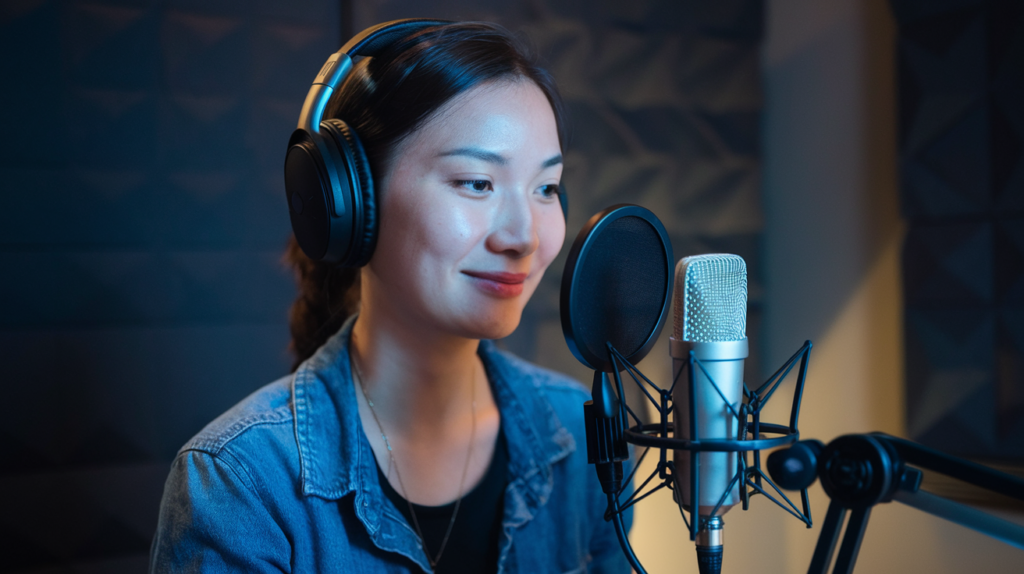Key Takeaways
- Diversity of Dialects: China has over 300 distinct dialects, with major ones including Mandarin, Cantonese, Wu, Min, and Hakka, each playing a crucial role in cultural identity.
- Authenticity in Media: Representation of Chinese dialects in films and television adds authenticity to characters and enhances emotional engagement with audiences.
- Historical Context Matters: The portrayal of dialects has evolved due to political changes and cultural shifts, leading to greater recognition and inclusion of regional identities in recent media.
- Impact on Audience Connection: Skilled voice actors fluent in various dialects help create relatable narratives that resonate deeply with local audiences while fostering understanding among diverse viewers.
- Stereotypes vs. Positive Representation: While media can perpetuate stereotypes about certain dialects, positive representations empower communities by celebrating their unique linguistic heritage.
- Case Studies Highlight Successes and Failures: Successful examples like “Crouching Tiger, Hidden Dragon” show effective dialect use; however, failures often stem from neglecting regional speech patterns or using unqualified voice actors.
Have you ever wondered how Chinese dialects are represented in media? It’s a fascinating topic that reveals so much about culture and identity. As global interest in Chinese cinema, television, and online content grows, understanding these dialects becomes crucial.
Overview of Chinese Dialects
Chinese dialects play a vital role in shaping cultural identity and communication. With over 300 distinct dialects, understanding these variations enhances appreciation for the richness of Chinese culture.
Major Chinese Dialects
Mandarin, Cantonese, Wu, Min, and Hakka represent some of the most prominent Chinese dialects.
- Mandarin: As the official language of China, Mandarin boasts over a billion speakers. It’s characterized by its four tones and is widely used in education and media.
- Cantonese: Predominantly spoken in Guangdong province and Hong Kong, Cantonese features six to nine tones. Its expressive nature makes it popular in films and music.
- Wu: This dialect includes Shanghainese and is known for its soft sounds. Wu speakers primarily reside in Shanghai and surrounding areas.
- Min: Including varieties like Hokkien and Teochew, Min is mainly spoken in Fujian province. It has unique phonetic characteristics that set it apart from other dialects.
- Hakka: Hakka speakers are scattered across various regions but are known for their strong sense of community. The dialect has distinctive intonations that reflect its diverse origins.
Importance of Dialect Representation
Dialect representation enriches media content by adding authenticity to characters and settings. Using specific dialects allows filmmakers to connect with regional audiences effectively.
Involving voice actors skilled in different Chinese dialects ensures accurate portrayals while elevating storytelling quality. Voiceovers can capture emotions uniquely tied to each region’s culture, making narratives resonate on a deeper level.
Overall, using diverse Chinese dialects strengthens cultural connections through media while fostering understanding among varied audience segments.
Historical Context
The representation of Chinese dialects in media has roots that reach deep into cultural history. Understanding this context reveals why dialect portrayal matters today.
Evolution of Language in Media
Language in media has transformed significantly over the years. Early films and radio shows primarily featured Mandarin, given its status as the official language. However, as regional cinema gained traction, dialects like Cantonese and Hakka found their voices too. This evolution reflects a growing recognition of diverse identities within China. Today, filmmakers use voice actors fluent in various dialects to add authenticity to stories, connecting with audiences on a deeper level. Authenticity enhances emotional engagement—imagine hearing a character express raw feelings through nuanced phrases unique to their background.
Impact of Political Changes
Political shifts have profoundly influenced how Chinese dialects appear in media. During certain historical periods, specific dialects faced suppression or marginalization due to national policies favoring Mandarin. As political climates changed, so did opportunities for regional expressions. Recent decades have seen increased support for preserving linguistic heritage; thus, filmmakers are more inclined to showcase local dialects prominently. This shift not only enriches narratives but also fosters pride among communities whose languages are represented accurately by skilled voice actors dedicated to capturing the essence of each dialect’s emotion and culture.
Current Representation of Chinese Dialects
Chinese dialects are increasingly represented in various media formats, enriching storytelling and cultural identity. The portrayal of these dialects reflects the diversity within Chinese communities, helping to foster connections among audiences.
Television and Film
Television and film play significant roles in showcasing Chinese dialects. Major productions often feature Mandarin due to its status as a national language, yet regional films increasingly embrace dialects like Cantonese and Hakka. This shift allows filmmakers to capture authentic local experiences. Skilled voice actors bring these characters to life by using their linguistic expertise to convey emotions effectively.
For instance, films set in Guangdong might prominently feature Cantonese, providing viewers with insight into the culture and nuances of daily life in that region. By employing voiceover talent familiar with these languages, filmmakers enhance authenticity while engaging local audiences more deeply.
Online Content and Social Media
Online content and social media platforms also reflect the growing representation of Chinese dialects. Short videos, vlogs, and livestreams frequently incorporate various dialects as creators aim for relatability with their audience. These platforms allow for direct communication between creators and viewers, fostering a sense of community around shared cultural elements.
Content creators utilize voice artists who resonate with specific regional accents or speech patterns, enhancing engagement through relatable expressions. For example, an influencer from Fujian may use Min during discussions about local cuisine or traditions, appealing directly to fellow speakers while attracting curious non-speakers interested in diverse cultures.
In both television/film and online spaces, leveraging skilled voiceover talent ensures that stories resonate authentically across different demographics—strengthening cultural ties while broadening understanding amidst a global audience.
Cultural Implications
Representation of Chinese dialects in media carries significant cultural implications. It shapes perceptions, fosters understanding, and highlights the rich diversity within Chinese communities.
Stereotypes and Misrepresentations
Media often perpetuates stereotypes surrounding certain dialects. These portrayals can lead to misconceptions about regional cultures. For instance, characters who speak a particular dialect may be unfairly characterized based solely on their speech patterns. Such misrepresentations not only undermine the complexity of these cultures but also risk alienating audiences who identify with those dialects.
Furthermore, the lack of nuanced representation can diminish the authenticity of narratives. When filmmakers use voice actors unfamiliar with specific dialects, it may result in performances that feel disingenuous or forced. Audiences crave genuine connections to stories; misrepresentation breaks that bond and fosters misunderstanding instead.
Positive Representations and Empowerment
Conversely, positive representations empower communities by showcasing their unique identities through authentic storytelling. Films and television shows that accurately depict various Chinese dialects celebrate linguistic heritage while also validating personal experiences within those communities. Skilled voice actors play a crucial role here—when they embody local accents and expressions authentically, it brings depth to characters and resonates more profoundly with viewers.
Moreover, embracing diverse dialects encourages dialogue about cultural pride and identity among younger generations. As these depictions become more mainstream, they inspire individuals to embrace their linguistic backgrounds rather than hide them away or conform to dominant narratives.
Representation matters deeply in media portrayals of Chinese dialects. By addressing stereotypes head-on while uplifting positive voices from within these communities, you contribute to a richer tapestry of storytelling that benefits everyone involved.
Case Studies
The representation of Chinese dialects in media showcases both successful examples and notable failures, highlighting the complexities involved.
Successful Examples
Several productions effectively incorporate Chinese dialects, enhancing authenticity and cultural resonance. For instance, films like Crouching Tiger, Hidden Dragon feature Mandarin alongside regional dialects, allowing audiences to connect deeply with characters’ emotions. Skilled voice actors bring these dialects to life through nuanced performances that reflect cultural subtleties. Another example is the television series The Untamed, which prominently showcases a blend of Mandarin and various regional speech patterns. This approach not only enriches storytelling but also attracts a diverse viewership familiar with different dialects.
In online platforms, creators leverage voiceover talent to convey relatable narratives using distinct dialects. Influencers on social media often utilize local languages to foster community engagement and share authentic experiences. Such portrayals allow viewers from different backgrounds to see themselves reflected in the content.
Notable Failures
Conversely, some representations fail to capture the essence of Chinese dialects accurately. A notable example is when major films rely solely on Mandarin despite featuring characters from regions where other dialects prevail. This oversight undermines authenticity and can alienate audiences who feel their linguistic heritage isn’t represented.
Additionally, instances arise where voiceovers lack cultural sensitivity or accuracy due to inadequate research or unqualified voice actors unfamiliar with specific dialect nuances. Such missteps may perpetuate stereotypes or create misunderstandings about regional cultures rather than fostering genuine connections.
Emphasizing accurate representation through skilled voice talents remains crucial for creating meaningful narratives that resonate across diverse communities. By recognizing both successes and failures in this area, filmmakers can strive for more inclusive storytelling that honors the rich tapestry of Chinese identities.
Conclusion
Understanding the representation of Chinese dialects in media is crucial for appreciating cultural diversity. By embracing various dialects filmmakers create authentic narratives that resonate with audiences on a deeper level. This not only enriches storytelling but also fosters pride within communities whose voices are often underrepresented.
As you engage with media featuring these dialects you’ll recognize the significant role they play in shaping perceptions and fostering understanding. The evolution towards more inclusive storytelling marks a positive shift that highlights the richness of Chinese identities while challenging stereotypes. Supporting accurate representations empowers both creators and viewers to appreciate the complexities of language and culture in an increasingly interconnected world.
Frequently Asked Questions
What is the significance of Chinese dialects in media?
Chinese dialects are crucial for understanding cultural identity and diversity. Their representation in media enriches storytelling by adding authenticity and allowing filmmakers to connect with regional audiences, ultimately strengthening cultural ties.
How many Chinese dialects exist?
There are over 300 distinct Chinese dialects. Major ones include Mandarin, Cantonese, Wu, Min, and Hakka. Each has unique characteristics and regional importance, contributing to the rich tapestry of Chinese culture.
Why have certain dialects faced suppression historically?
Political changes throughout history have led to the suppression of specific dialects. This often reflected broader societal shifts and attempts at unifying language standards during various governance periods.
How do skilled voice actors contribute to dialect representation?
Skilled voice actors enhance authenticity by accurately portraying emotions tied to each dialect. Their performances capture the essence of local cultures, making narratives more relatable and meaningful for diverse audiences.
What role does online content play in representing Chinese dialects?
Online content fosters relatability among audiences by using various Chinese dialects. It allows creators to showcase regional identities while building community connections through shared linguistic experiences on social media platforms.
Can misrepresentation of dialects lead to stereotypes?
Yes, misrepresentation can perpetuate stereotypes about certain regions and cultures within China. Lack of nuanced portrayals diminishes authenticity and may reinforce misconceptions about communities’ complexities.
Are there any successful examples of media incorporating Chinese dialects effectively?
Yes, films like “Crouching Tiger, Hidden Dragon” and series such as “The Untamed” successfully incorporate multiple dialects. These productions enhance cultural resonance through authentic voice performances that reflect true regional experiences.
What can be done to improve representation of Chinese dialects in media?
To improve representation, filmmakers should prioritize inclusivity by casting skilled voice actors familiar with specific dialects. Emphasizing accurate portrayals will create richer narratives that celebrate the diversity within Chinese communities.







